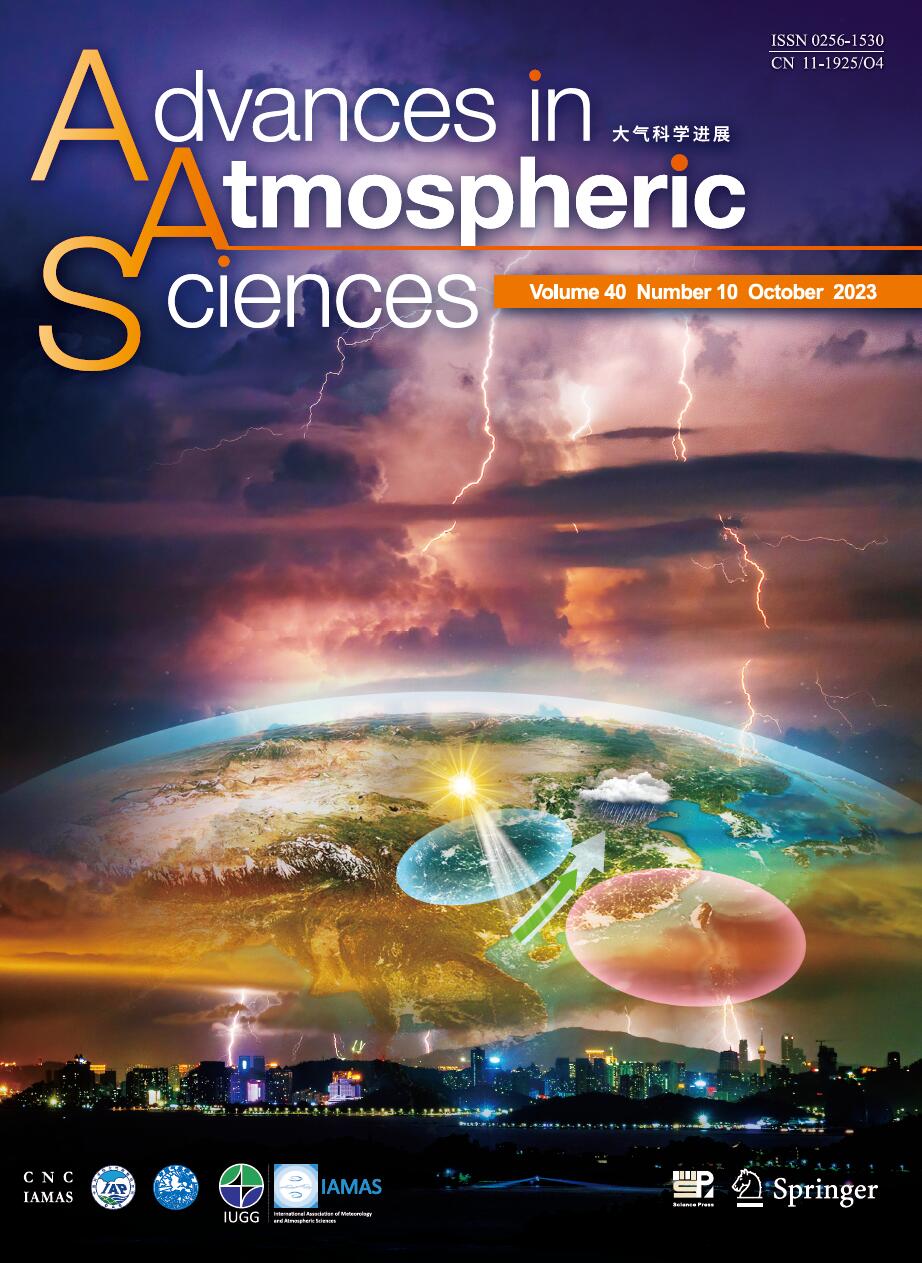| [1] |
Dehai LUO, Binhe LUO, Wenqi ZHANG,
2023: A Perspective on the Evolution of Atmospheric Blocking Theories: From Eddy-Mean flow Interaction to Nonlinear Multiscale Interaction, ADVANCES IN ATMOSPHERIC SCIENCES, 40, 553-569.
doi: 10.1007/s00376-022-2194-z
|
| [2] |
Li Zhijin, Ji Liren,
1996: Internal Dynamics of the Generation of Atmospheric Teleconnection Patterns, ADVANCES IN ATMOSPHERIC SCIENCES, 13, 19-32.
doi: 10.1007/BF02657025
|
| [3] |
Zhang Mingli,
1988: TELECONNECTION OF THE DOMINANT SPATIAL PATTERNS OF THE SEASONAL 500 hPa GPH FIELD, ADVANCES IN ATMOSPHERIC SCIENCES, 5, 421-436.
doi: 10.1007/BF02656788
|
| [4] |
Hoffman H. N. CHEUNG, Wen ZHOU,
2016: Simple Metrics for Representing East Asian Winter Monsoon Variability: Urals Blocking and Western Pacific Teleconnection Patterns, ADVANCES IN ATMOSPHERIC SCIENCES, 33, 695-705.
doi: 10.1007/s00376-015-5204-6
|
| [5] |
Shi Neng, Zhu Qiangen,
1993: Studies on the Northern Early Summer Teleconnection Patterns, Their Interannual Variations and Relation to Drought / Flood in China, ADVANCES IN ATMOSPHERIC SCIENCES, 10, 155-168.
doi: 10.1007/BF02919138
|
| [6] |
Shengping HE, Yongqi GAO, Tore FUREVIK, Huijun WANG, Fei LI,
2018: Teleconnection between Sea Ice in the Barents Sea in June and the Silk Road, Pacific-Japan and East Asian Rainfall Patterns in August, ADVANCES IN ATMOSPHERIC SCIENCES, 35, 52-64.
doi: 10.1007/s00376-017-7029-y
|
| [7] |
GU Zhaolin, QIU Jian, ZHAO Yongzhi, LI Yun,
2008: Simulation of Terrestrial Dust Devil Patterns, ADVANCES IN ATMOSPHERIC SCIENCES, 25, 31-42.
doi: 10.1007/s00376-008-0031-7
|
| [8] |
LIU Ge, JI Liren, SUN Shuqing, ZHANG Qingyun,
2010: An Inter-hemispheric Teleconnection and a Possible Mechanism for Its Formation, ADVANCES IN ATMOSPHERIC SCIENCES, 27, 629-638.
doi: 10.1007/s00376-009-8172-x
|
| [9] |
Xiaozhen LIN, Chaofan LI, Riyu LU, Adam A. SCAIFE,
2018: Predictable and Unpredictable Components of the Summer East Asia-Pacific Teleconnection Pattern, ADVANCES IN ATMOSPHERIC SCIENCES, 35, 1372-1380.
doi: 10.1007/s00376-018-7305-5
|
| [10] |
WANG Lu, and YANG Haijun,
2014: The Role of Atmospheric Teleconnection in the Subtropical Thermal Forcing on the Equatorial Pacific, ADVANCES IN ATMOSPHERIC SCIENCES, 31, 985-994.
doi: 10.1007/s00376-013-3173-1
|
| [11] |
Peiqun ZHANG, Song YANG, Vernon E.KOUSKY,
2005: South Asian High and Asian-Pacific-American Climate Teleconnection, ADVANCES IN ATMOSPHERIC SCIENCES, 22, 915-923.
doi: 10.1007/BF02918690
|
| [12] |
ZHU Weijun, Yongsheng ZHANG,
2009: Summertime Atmospheric Teleconnection Pattern Associated with a Warming over the Eastern Tibetan Plateau, ADVANCES IN ATMOSPHERIC SCIENCES, 26, 413-422.
doi: 10.1007/s00376-009-0413-5
|
| [13] |
WANG Huijun,
2005: The Circum-Pacific Teleconnection Pattern in Meridional Wind in the High Troposphere, ADVANCES IN ATMOSPHERIC SCIENCES, 22, 463-466.
doi: 10.1007/BF02918759
|
| [14] |
LUO Dehai, YAO Yao,
2014: On the Blocking Flow Patterns in the Euro-Atlantic Sector: A Simple Model Study, ADVANCES IN ATMOSPHERIC SCIENCES, 31, 1181-1196.
doi: 10.1007/s00376-014-3197-1
|
| [15] |
Iman ROUSTA, Mehdi DOOSTKAMIAN, Esmaeil HAGHIGHI, Hamid Reza GHAFARIAN MALAMIRI, Parvane YARAHMADI,
2017: Analysis of Spatial Autocorrelation Patterns of Heavy and Super-Heavy Rainfall in Iran, ADVANCES IN ATMOSPHERIC SCIENCES, 34, 1069-1081.
doi: 10.1007/s00376-017-6227-y
|
| [16] |
Claudia Christine STEPHAN, Yan Ho NG, Nicholas P. KLINGAMAN,
2018: On Northern Hemisphere Wave Patterns Associated with Winter Rainfall Events in China, ADVANCES IN ATMOSPHERIC SCIENCES, 35, 1021-1034.
doi: 10.1007/s00376-018-7267-7
|
| [17] |
ZHANG Zhongshi, WANG Huijun, GUO Zhengtang, JIANG Dabang,
2006: Impact of Topography and Land-Sea Distribution on East Asian Paleoenvironmental Patterns, ADVANCES IN ATMOSPHERIC SCIENCES, 23, 258-266.
doi: 10.1007/s00376-006-0258-0
|
| [18] |
SONG Lianchun, A. J. CANNON, P. H. WHITFIELD,
2007: Changes in Seasonal Patterns of Temperature and Precipitation in China During 1971--2000, ADVANCES IN ATMOSPHERIC SCIENCES, 24, 459-473.
doi: 10.1007/s00376-007-0459-1
|
| [19] |
ZHENG Bin, GU Dejun, LIN Ailan, LI Chunhui,
2008: Spatial Patterns of Tropospheric Biennial Oscillation and Its Numerical Simulation, ADVANCES IN ATMOSPHERIC SCIENCES, 25, 815-823.
doi: 10.1007/s00376-008-0815-9
|
| [20] |
Chibuike Chiedozie IBEBUCHI,
2023: Circulation Patterns Linked to the Positive Sub-Tropical Indian Ocean Dipole, ADVANCES IN ATMOSPHERIC SCIENCES, 40, 110-128.
doi: 10.1007/s00376-022-2017-2
|















 AAS Website
AAS Website 
 AAS WeChat
AAS WeChat 
 DownLoad:
DownLoad: